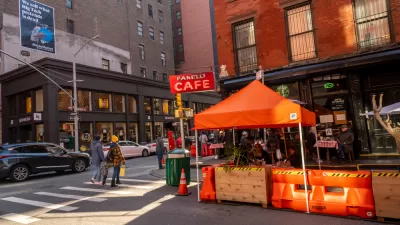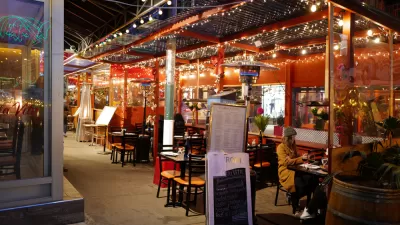An emergency ordinance signed by the city's mayor will allow restaurants to keep outdoor dining facilities built during the pandemic for at least one more year.

To "continue to support restaurants and bars throughout the ongoing pandemic," Los Angeles Mayor Eric Garcetti has extended several COVID-era policies, writes Mona Holmes for Eater LA. The emergency ordinance, "set to become codified in the next two weeks, provides sweeping clarity on several fronts, including the continuation of outdoor dining spaces for business across the county." The city's outdoor dining program, known as LA Al Fresco, "would be allowed to continue for at least the next 12 months, with the possibility of extension for another two years beyond that date if approved by the City Council down the line." The program, launched in May 2020, was briefly suspended in December as COVID-19 cases in the city climbed.
"Garcetti’s emergency ordinance also updates the city’s parking variance needs related to changes of use for restaurant spaces up to 5,000 square feet. While wonky, the policy essentially means that new and existing restaurants can suspend the need to provide a set number of on or off-site parking spots for cars, freeing up the city for more business density and a more transit-oriented approach to everyday life — to say nothing of the reduced fees needed for opening a business in the first place."
F E Design and Consulting’s Eddie Navarette "sees a lot of potential in this ordinance, including changes regarding parking and the coveted and expensive alcohol licenses from California Department of Alcoholic Beverage Control." Navarette also says the new rules will free up public servants "from the cumbersome process of permitting for things like parking variances" and reduce the workload for city departments whose budgets were reduced during the pandemic.
FULL STORY: LA Mayor Agrees to Keep Outdoor Dining Spaces for at Least a Year

Maui's Vacation Rental Debate Turns Ugly
Verbal attacks, misinformation campaigns and fistfights plague a high-stakes debate to convert thousands of vacation rentals into long-term housing.

Planetizen Federal Action Tracker
A weekly monitor of how Trump’s orders and actions are impacting planners and planning in America.

San Francisco Suspends Traffic Calming Amidst Record Deaths
Citing “a challenging fiscal landscape,” the city will cease the program on the heels of 42 traffic deaths, including 24 pedestrians.

Adaptive Reuse Will Create Housing in a Suburban Texas Strip Mall
A developer is reimagining a strip mall property as a mixed-use complex with housing and retail.

Study: Anti-Homelessness Laws Don’t Work
Research shows that punitive measures that criminalized unhoused people don’t help reduce homelessness.

In U.S., Urban Gondolas Face Uphill Battle
Cities in Latin America and Europe have embraced aerial transitways — AKA gondolas — as sustainable, convenient urban transport, especially in tricky geographies. American cities have yet to catch up.
Urban Design for Planners 1: Software Tools
This six-course series explores essential urban design concepts using open source software and equips planners with the tools they need to participate fully in the urban design process.
Planning for Universal Design
Learn the tools for implementing Universal Design in planning regulations.
Heyer Gruel & Associates PA
JM Goldson LLC
Custer County Colorado
City of Camden Redevelopment Agency
City of Astoria
Transportation Research & Education Center (TREC) at Portland State University
Jefferson Parish Government
Camden Redevelopment Agency
City of Claremont





























